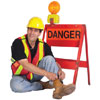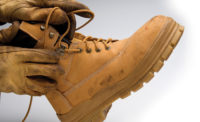
There are almost as many variations in workplace safety footwear programs as there are workplaces. OSHA’s occupational foot protection regulations (1910.136) give employers fairly wide latitude in instituting programs.
Reimbursement programs
Many workplaces operate some type of safety shoe reimbursement program. Employees might be eligible to receive reimbursements of various price points usually for approved safety shoes as outlined in the company selection guidelines. In some programs, employees can submit a reimbursement application form once per calendar year to cover their purchase of one pair of safety shoes up to the dollar limit. Applications must be accompanied by the original itemized sales receipt.
Supervisors play a key role
Supervisors often play a central role in effective protective footwear programs. Many times it is an employee’s direct supervisor who approves or authorizes the employee to go beyond the program’s defined requirements and become eligible for reimbursement for the purchase of approved safety shoes.
The EHS department at a worksite is usually charged with designating those occupational classifications for which wearing safety shoes is required, based on the OSHA-required hazard assessment. EHS staff ensure uniform and consistent practices among employees required to wear protective footgear, and handle waivers exempting some employees from requirements.
EHS staff also often serve as quality control monitors of protective footwear programs. They might be responsible for ensuring that any alternative footgear has been evaluated and approved prior to use by an employee.
Replacement and repair
Policies vary company to company on replacement and repair of safety shoes. In some programs, safety shoes are replaced or repaired on an “as needed” basis as determined by the EHS department.
Policies also vary when it comes to protective footgear that is lost, misplaced, or for any reason unavailable after issue. Often the shoes must be replaced by the employee to whom it was issued.
In one laboratory, employees working in areas where there is a danger of foot injuries due to falling or rolling objects, or objects piercing the sole, may be authorized to purchase safety shoes. When safety shoes are required by laboratory policy, the department requesting them contributes a set amount (allowance) toward their cost. The current annual allowance for safety shoes in this program is set at $150. If the employee selects safety shoes for which the total cost (including sales tax) exceeds this allowance, the difference must be paid by the employee. The employee takes the signed, completed Shoe Issuance Form to the shoemobile, and selects an appropriate type of protective footwear. Upon completion of the transaction, the first copy of the form is retained by the shoemobile vendor for submittal to accounts payable, with the shoemobile invoice. Any cost above the allowance can be paid by payroll deduction, or paid by the employee at the time of purchase.

